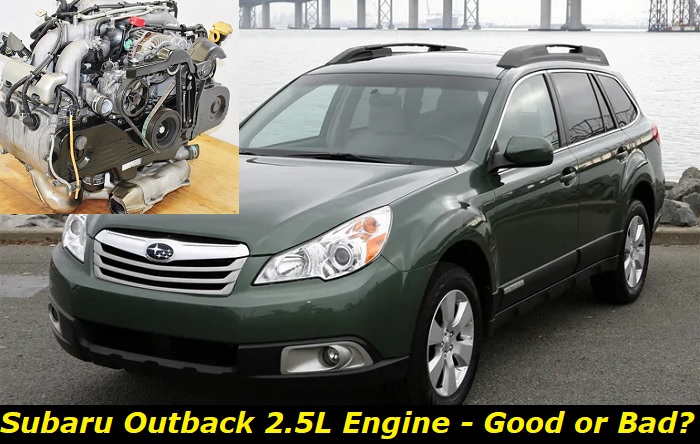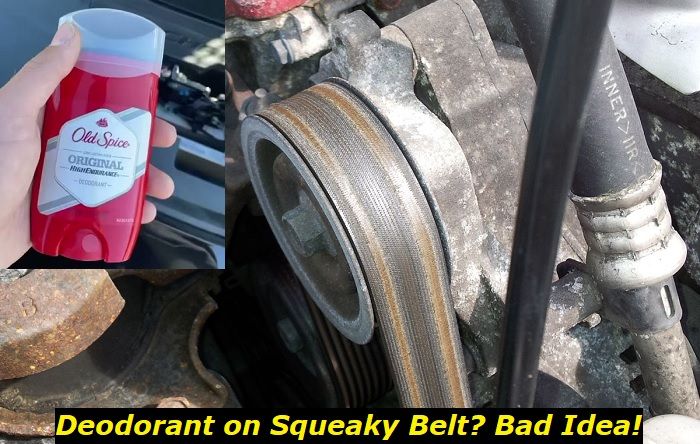The Subaru Outback has a host of features that make it a smart choice for an SUV. Its base may be closer to the ground than its counterparts in the market, but it sure does make it up for its dynamic design. One of the longest-running engines used by the auto was the 2.5L engine which garnered mixed reviews from users over the years.
The 2.5L EJ25 engines used by Subaru for the 1996 to 2012 models of the Outback were a bit of a mixed bag. They were praised by many and hated by a number of other users. In this article, we will take a look at the reasons why this is the case with this product.

Key features and my opinion about the engine
- Production years:1994-2024
- Average lifespan of EJ25:150,000-190,000 miles
- Fuel supply type:port injection
- Power range:155-310 hp
- Fuel efficiency:average
- Engine block material:aluminum
- Engine reliability score:medium
- The most common problems:extremely afraid of overheating, oil consumption, numerous leaks.
Durability of the 1996-2012 Subaru Outback 2.5L Engine
Before 2009, the 2.5L engine of Subaru was rife with major problems that threatened users with possible engine failure and expensive repairs. The main culprit in most of its troubles was the way that its gasket was designed. This was eventually fixed in the latter model years of the engine though.
Despite its infamy, the newer models of the Subaru 2.5L engine may go between 250,000 and 300,000 miles before requiring significant vehicle maintenance, overhaul, or replacement. Given that the average driver travels roughly 14,000 miles per year, you may be able to stretch the life of this unit by more than two decades. Of course, this should be coupled with responsible use and regular maintenance.
Common Problems in 1996-2012 Subaru Outback 2.5L Engines
According to user testimonies and expert advice from mechanics in various reports, forums, and review sites, there are certain issues that the 2.5L engine of Subaru is mostly prone to. These include the following:
1. Worn Gasket
The gasket in the engine of your Subaru Outback 2.5L EJ25 plays an important role in stopping the engine oil and coolant from mixing. Over time, these gaskets can become worn or damaged. In the case of Subaru vehicles produced before 2009, gasket failure was very common in their boxer engines.
There are several symptoms of worn or damaged gaskets in the engine. The most common is an oil leak. This can be diagnosed by checking for oil on the ground beneath the car or by monitoring the oil level on the dipstick. If the oil level is constantly low even if it hasn't been long since you topped up, it may be due to a leak.
Another symptom of worn or damaged gaskets is overheating. This is the worst that could happen when there's a leak in the coolant system. If the engine overheats, it can lead to serious engine damage or even fire.
If you suspect that your gaskets are worn or damaged, it is important to have them replaced as soon as possible. Depending on the severity of the problem, you may need to replace just the gaskets or the entire engine. Most of the time, the latter serves as a more economical option as a gasket replacement can go up for nearly the price of the engine itself.
If you're not sure what's wrong, it's always best to consult a professional mechanic. They will be able to diagnose the problem and recommend the best course of action.
2. Fuel Pump Failure
The fuel pump in the engine is responsible for supplying fuel to the engine. It is a vital component of the engine and its failure can cause serious problems.
The symptoms of fuel pump failure include loss of power, stalling, and difficulty starting the engine. If these symptoms are not addressed immediately, they could easily become worse and lead to more issues.
To diagnose the possible causes of fuel pump failure, a mechanic will first check the fuel system for leaks. If no leaks are found, the mechanic will then test the pump itself for proper operation. If the pump is not working properly, it will need to be replaced.
In some cases, fuel pump failure may be caused by a clogged fuel filter. This can be diagnosed by checking the pressure of the fuel system. If the pressure is too low, the filter will need to be replaced.
Finally, if all else fails, the mechanic may need to replace the entire fuel system. This includes the fuel pump, fuel lines, and fuel injectors. Replacing the entire system is a last resort, but it may be necessary if the problem cannot be otherwise resolved.
3. Piston Ring Leaks
Piston rings are critical components in an engine, as they help to seal the combustion chamber and prevent oil leaks. In a Subaru Outback 2.5L engine, there are three piston rings per cylinder-two compression rings and one oil control ring.
Compression rings seal the combustion chamber so that all of the gases created during the combustion process can be used to power the engine. Oil control rings work to scrape oil from the cylinder walls and return it to the crankcase.
Leaking piston rings can cause many problems, including increased oil consumption, loss of power, and decreased fuel economy. If ignored for a long time, these problems can create more issues that may ultimately result in engine damage.
To diagnose leaking piston rings, a mechanic will first do a compression test to see if there is any pressure loss in the cylinders. If the compression test shows that there is pressure loss, then the mechanic will likely do a leakdown test to pinpoint the location of the leak.
Once the source of the leak has been identified, the mechanic will determine the best course of action to fix it. This may involve replacing one or more piston rings. Sometimes, the entire engine may need to be rebuilt or even replaced, whichever is the more practical solution if the damage is already grave.
4. Stuck Valves
The engine valves are an important part of the Subaru Outback 2.5L engine. They are responsible for opening and closing the intake and exhaust ports in the cylinder head. This allows air and fuel to enter the cylinders, and exhaust gases to exit.
An engine valve not closing or opening properly can trigger major problems. The engine may run rough, or misfire. Additionally, it may experience a loss of power or poor fuel economy. If the problem is not addressed immediately, it can lead to more headaches for you.
To diagnose the possible causes of this problem, a mechanic will first check the valve clearance. If the clearance is too great, it can prevent the valve from closing properly. Additionally, the mechanic will check for any leaks in the intake or exhaust system. This can also cause the valves to not close properly. Finally, the mechanic will check the engine timing. If the timing is off, it can also cause the valves to not close properly.
Once the cause of the problem has been determined, the mechanic will then proceed with the appropriate repair. This may involve adjusting the valve clearance or replacing parts in the intake or exhaust system. In some cases, it may be necessary to replace the engine valves themselves.
5. Carbon Build-Up
The 2.5L engines of the Outback are already between 10 and 26 years old by now. Therefore, one of the problems you may likely run into is carbon build-up, which may have developed gradually throughout the engine's lifetime.
Carbon buildup in the engine can cause a lot of problems. The most common symptom is a loss of power. The engine may also run rough, and the check engine light may come on. If the problem is not addressed immediately, it can lead to engine failure.
There are several ways to diagnose carbon build-up. The most common way is to look for soot on the spark plugs. Another way is to use a borescope to inspect the combustion chamber. A third way is to do a compression test.
There are several possible solutions to carbon build-up. The most common solution is to clean the intake and exhaust manifolds. This can be done with a wire brush or with chemical cleaners. Another solution is to replace the spark plugs. A third solution is to replace the intake and exhaust valves.
Carbon build-up is a common problem in engines not just in the Outback, but it can be fixed with the right tools and knowledge. With a little investment in repairs and maintenance, you can keep your engine running smoothly for years to come.
1996-2012 Subaru Outback 2.5L Engine Key Specs
The EJ series 2.5-liter engine debuted in 1995. The EJ25 engine is the largest of the EJ engines, which include the EJ15, EJ16, EJ18, EJ20, and EJ22. The engine was a staple in all of the brand's key models during its run, and one of its key applications was in the 1996 to 2012 models of the Outback SUV.
The EJ25D flat-four engine, the introductory model of the EJ25, carried on the same block utilized by the EJ20 engine that preceded it. The unit has DOHC aluminum cylinder heads with four valves per cylinder. It utilized a timing belt to operate the camshafts and EJ motors.
In its earliest form, the engine had an output of 155hp at 5,600 rpm and 140 lb-ft of torque at 2,800 rpm. However, it got new pistons and its output was increased to 165hp in 1997. A year later, the setup was ditched in favor of the EJ251 engine, which was highlighted by its SOHC heads, new pistons, and a higher compression ratio of 10.1:1.
In the years that followed, the engine had gradually undergone a series of transformations to include a turbocharger in 2004. Along the way, updates were also introduced to address the head gasket issue that has plagued owners over the years.
By 2012, the flat-four engine was rated at 170 hp at 6,000 rpm and 176 lb-ft of torque at 2,800 rpm. Albeit still underpowered in its latter years, it was no longer prone to the problems experienced by its early models, particularly the head gasket issues.
Conclusion
The EJ engine version used by the Subaru Outback from 1996 to 2012 certainly came off from a rough start. As they say, "First impressions last." So, unfortunately, this engine has been primarily linked by the public to head gasket problems. In reality though, Subaru has done a great job in addressing the problem, and as mentioned, was able to extend the life of the engine to last for decades and over 250,000 miles with proper maintenance.
About the authors
The CarAraC research team is composed of seasoned auto mechanics and automotive industry professionals, including individuals with advanced degrees and certifications in their field. Our team members boast prestigious credentials, reflecting their extensive knowledge and skills. These qualifications include: IMI: Institute of the Motor Industry, ASE-Certified Master Automobile Technicians; Coventry University, Graduate of MA in Automotive Journalism; Politecnico di Torino, Italy, MS Automotive Engineering; Ss. Cyril and Methodius University in Skopje, Mechanical University in Skopje; TOC Automotive College; DHA Suffa University, Department of Mechanical Engineering






Add comment